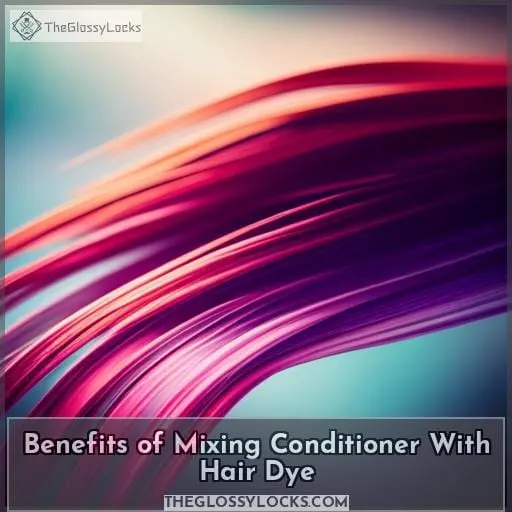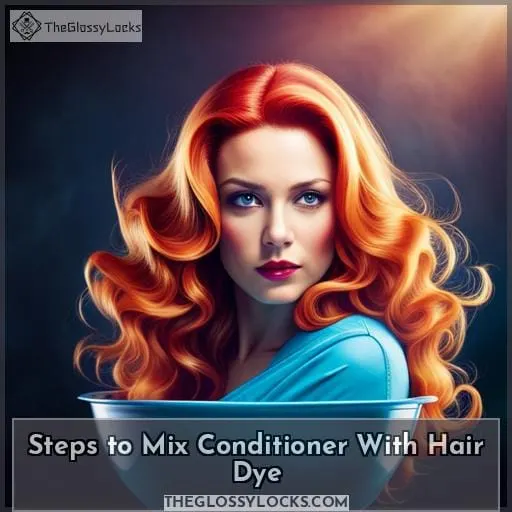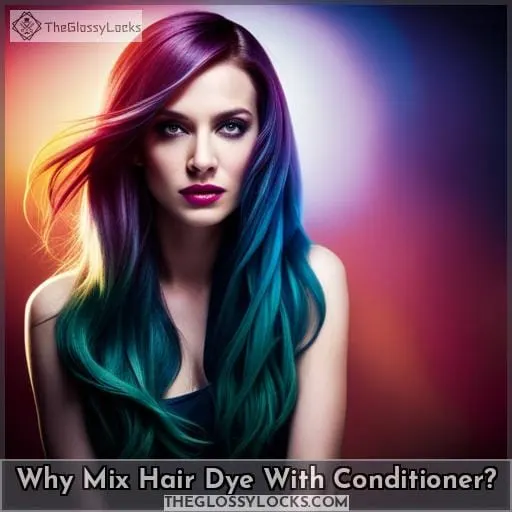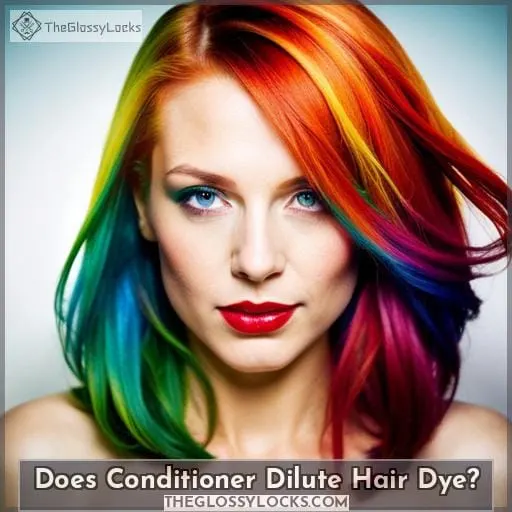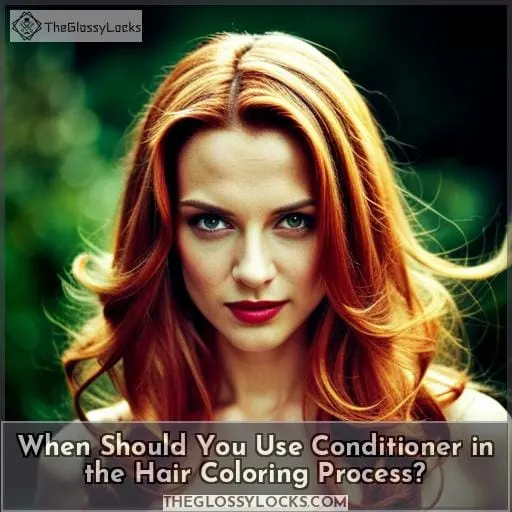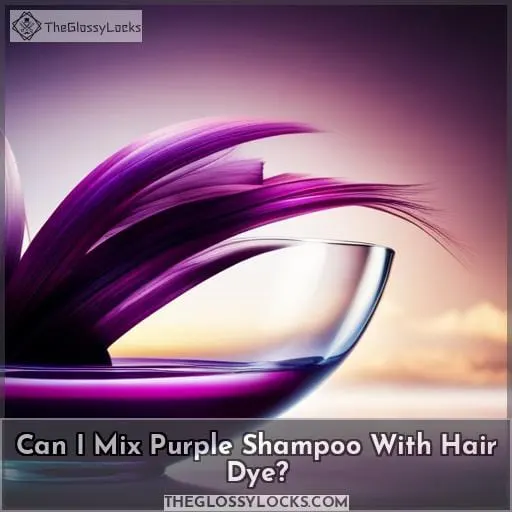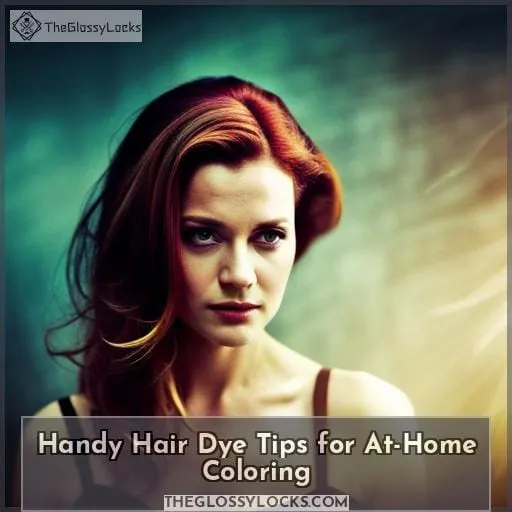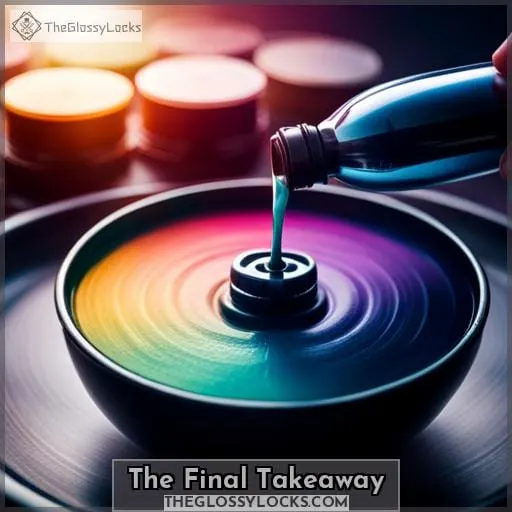This site is supported by our readers. We may earn a commission, at no cost to you, if you purchase through links.
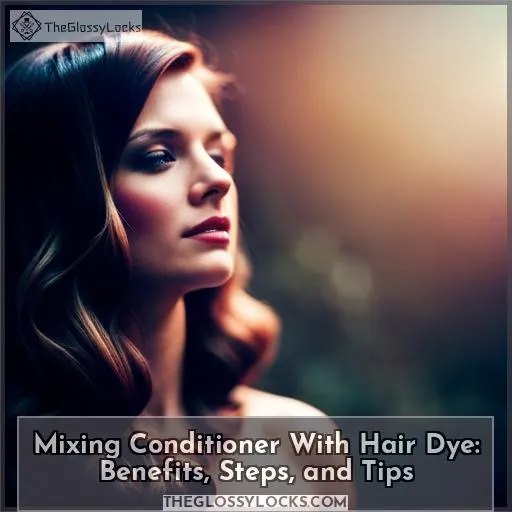 As the beauty industry continues to evolve, so too does our experimentation with hair colour. Mixing conditioner with hair dye is one of the latest trends that has taken over social media. Not only can it create custom shades by blending different dyes, but its benefits extend far beyond simply colouring your locks.
As the beauty industry continues to evolve, so too does our experimentation with hair colour. Mixing conditioner with hair dye is one of the latest trends that has taken over social media. Not only can it create custom shades by blending different dyes, but its benefits extend far beyond simply colouring your locks.
It can protect against harsh chemicals, revive existing tints, and maintain a soft texture throughout.
In this article, we’ll explore exactly why you should mix conditioner with your chosen hue. We’ll also provide detailed steps on how to get started and some handy tips for at-home coloring.
So if you’re looking for an easy way to experiment safely without sacrificing shine or softness in your strands, then read on!
Table Of Contents
- Key Takeaways
- Benefits of Mixing Conditioner With Hair Dye
- Steps to Mix Conditioner With Hair Dye
- Why Mix Hair Dye With Conditioner?
- Does Conditioner Dilute Hair Dye?
- When Should You Use Conditioner in the Hair Coloring Process?
- Can I Mix Purple Shampoo With Hair Dye?
- Handy Hair Dye Tips for At-Home Coloring
- The Final Takeaway
- Conclusion
Key Takeaways
- Custom shades
- Protection from chemicals
- Texture maintenance
- Revive existing tints
Benefits of Mixing Conditioner With Hair Dye
Mixing conditioner with hair dye is a popular beauty trend for those looking to reap the benefits of subtle color and protection from harsh chemicals. Not only can it maintain a soft, smooth texture, but also lighten and blend colors while revitalizing the existing shade.
With these advantages in mind, mixing conditioner with hair dye offers an opportunity for creative expression as well as natural-looking results.
Protection From Harsh Chemicals
By mixing conditioner with dye, you can help protect your hair from harsh chemicals while enjoying beautiful color. The benefits of this combination include chemical protection, improved color vibrancy, and hydration benefits for a revitalized look.
Conditioners to mix with hair dye vary in strength, but all create a protective shield against damaging components found in most at-home coloring options.
Maintaining Soft and Smooth Texture
This allows you to enjoy the silky smoothness of your hair while also getting a vibrant color. Mixing conditioner with hair dye helps preserve its hue and boosts hydration for an overall healthier look.
Detangling benefits come from the nourishing ingredients in most conditioners, while curl revitalization can be achieved through natural oils or rich creams.
With the right product combination, at-home coloring becomes easier than ever before! Hair care should always include conditioning prior to any chemical process. This ensures that locks remain soft and manageable throughout application and after rinsing off excess dye.
Diluting and Blending Color
You can easily create custom shades with conditioner and dye to give your hair a unique look. For example, mixing just a tablespoon of dye with ⅓ cup of conditioner will lighten the color intensity by up to 30%.
You can also use this DIY technique for color maintenance, as it helps retain vibrancy while diluting harsh chemicals in permanent dyes. When using semi-permanent colors, opt for pale shade conditioners that won’t overpower the hue you’re trying to achieve.
Follow application instructions carefully and refer to coloring tips for better results! With product recommendations like WOW Coconut Avocado Hair Conditioner or Keracolor Clenditioner Purple Hair at hand, there’s no limit when it comes to creating custom hues with mixing conditioner and hair dye!
Revitalizing Existing Color
Revitalizing existing color with conditioner and dye allows you to customize the hue for a vibrant look. Use semi-permanent colors when mixing, as permanent shades can result in uneven mottling. For best results, opt for pale shade conditioners and combine ⅓ cup with one tablespoon of hair dye before blending into the remaining mixture.
Color revitalization is protected by using sulfate-free shampoo post coloring while protecting from harsh chemicals during the process.
Mixing purple shampoo in a 50/50 ratio corrects tones and adds shine too! Experiment cautiously but enjoy these new creative opportunities that mix offers your locks!
Steps to Mix Conditioner With Hair Dye
Are you looking to mix conditioner with hair dye? Choosing the right dye is essential for achieving your desired results. Select a suitable conditioner, such as WOW Coconut Avocado Hair Conditioner or Moroccan Argan Oil Conditioner, then mix in ⅓ cup of the chosen product with one tablespoon of hair dye.
Thoroughly blend before adding it to the remaining color and follow the box instructions accordingly for best results.
Choosing the Right Hair Dye
To achieve the desired hair coloring results, it’s important to select a dye that complements your natural color and type of hair. Hair types vary from 3A-4C, so choose vibrant shades for the best coverage. Product compatibility with conditioner is also key: permanent dyes can mottle when mixed, while semi-permanent colors may be diluted for custom blending.
To maintain color integrity over time, use sulfate-free shampoo post-dyeing and consider using bonding creams before lightening strands.
Selecting a Suitable Conditioner
Finding the perfect conditioner to help you color your hair can be a daunting task, but with some guidance on product selection and compatibility, it can become an easy process!
Selecting a suitable conditioner for mixing with dye depends on the desired effect. For protecting hair from harsh chemicals while maintaining softness and texture, use sulfate-free options like WOW Coconut Avocado Hair Conditioner or Moroccan Argan Oil Conditioner.
To dilute direct dyes, opt for lighter shades of pale conditioners such as Coconut Milk Hydrolyzed Keratin or Mongongo Oil Hydrating Creams by Mielle Organics.
With these tips in mind, you’ll have beautiful colored tresses without any damage!
Mixing Proportions
When mixing conditioner with hair dye, it’s important to determine the right proportions for your desired look. Mixing ratios can vary from 1:3 (one part conditioner and three parts dye) up to a 50/50 ratio, depending on product compatibility.
The more diluted mixture will result in subtle color blending, while higher concentrations will lead to vibrant results and custom shades. When used correctly, this method also helps protect hair by diluting harsh chemicals found in dyes or reviving existing hair color without damaging strands further.
Thoroughly Mixing the Mixture
Gently stir the creamy mixture until it’s completely blended for an even color. Use a mixing spoon or brush to ensure dye and conditioner are evenly distributed. Take care not to over-stir, as this could damage the consistency of the hair dye.
For best results, use your fingers in a circular motion around the bowl during stirring so that all ingredients combine properly without any clumps remaining.
Ensure protection from harsh chemicals by adding more conditioner mix if desired – allowing you to customize shades while protecting your locks at every step along the way!
Following Box Instructions for Coloring
After mixing the conditioner and dye, refer to your box instructions for guidance on how and when to apply the mixture. It’s important to adhere to the application duration to protect your hair from harsh chemicals.
Generally, lighter shades require less time than darker colors as permanent dyes can quickly achieve color intensity. Timing is essential for achieving the desired results. Too little or too much of a certain shade will completely change its hue! Customize your look by blending different shades together or using a diluted tone for subtle color maintenance.
Why Mix Hair Dye With Conditioner?
Mixing conditioner with your favorite hair dye can offer an array of exciting possibilities, like creating custom shades and protecting your hair from harsh chemicals.
- Color Mixing: Adding a pale conditioner to vibrant dyes allows for more creative control over the final results.
- Dye Customization: Diluting semi-permanent colors with conditioners provides subtle hints of color that look natural and enhance existing hues without damaging the strands.
- Conditioner Benefits: By adding moisture, it helps protect against dryness caused by chemical processes like coloring or toning while nourishing each strand in between salon visits.
- Hair Color Vibrancy: Using a combination of both products can result in longer-lasting color vibrancy due to better absorption into each strand as well as improved conditioning effects on porous strands that tend to lose their luster quickly after application.
DIY Coloring made easy! All these features make mixing conditioner with hair dye not only convenient but also beneficial for achieving long-lasting results when done correctly.
Does Conditioner Dilute Hair Dye?
When it comes to customizing color, you can use conditioner to dilute and soften the intensity of dye. Conditioning benefits, like protecting hair from harsh chemicals or maintaining a smooth texture, are great reasons for mixing.
The ratio is usually 1 part conditioner to 3 parts dye for semi-permanent colors.
Permanent hair coloring should never be mixed with conditioner as it could result in an uneven mottled look. However, commercial formulas might not be affected by adding some extra moisture into the mix.
With regular maintenance using sulfate-free shampoo and conditioners after 72 hours of dyeing, you can extend that new beautiful hue even further!
When Should You Use Conditioner in the Hair Coloring Process?
Ready to color your hair? Before you begin, consider pre-conditioning with a conditioner. Pre-coloring conditioning helps protect the hair from harsh dye chemicals and can help maintain a smooth texture throughout the coloring process.
Conditioners can also be used for customizing color by diluting permanent or semi-permanent dyes and revitalizing existing colors.
Here are four tips when using conditioner in the hair coloring process:
- Use pale shade conditioners – Opt for pale shades as they won’t affect the hue of your desired result too drastically while still helping achieve an even distribution of color.
- Mix correctly – When mixing 1 part dye with 3 parts conditioned mix thoroughly before applying it to ensure that everything is blended together evenly.
- Choose quality products – Look for sulfate-free shampoo and conditioner, as well as natural ingredients such as hydrolyzed keratin, niacin & vitamin E.
- Follow instructions – Read all product instructions carefully so that you know exactly how long to leave on each step of the coloring process.
With these simple steps, you’ll soon have beautiful colored locks!
Can I Mix Purple Shampoo With Hair Dye?
You can customize your hair color by blending purple shampoo with dye to achieve the perfect look. Purple shampoo is a great way to tone and correct colors while maintaining vibrancy. It’s also compatible with both semi-permanent and permanent dyes, making it ideal for DIY coloring projects.
When mixing purple shampoo and hair dye, use a 50/50 ratio to protect your hair from harsh chemicals while still getting a vibrant result. For best results, apply directly after coloring as this will help maintain the toning effects of the dye over time.
Additionally, you can mix conditioner into your color mixture for added shine or dilution of intensity when desired – just make sure not to use any conditioner during application if using permanent dyes!
With these tips in mind, try out different combinations of purple shampoos and hair dyes until you find one that works for you.
Handy Hair Dye Tips for At-Home Coloring
It’s important to take proper precautions when coloring your hair at home. Before you begin, make sure to do a patch test in order to check for allergies and skin tone compatibility. During the application process, it is advised that you leave your hair down for even coverage of color.
You can also spritz water on the dye and lightly massage it into the scalp and strands for more consistent results.
Patch Test and Skin Tone Compatibility
Before using any hair dye, it’s important to always perform a patch test. This includes taking allergy precautions and matching your skin tone for color sensitivity.
To ensure the best results with your chosen hair dye mix, use quality products that are specifically designed for mixing.
It’s essential to protect your hair from harsh chemicals. You can do this by conditioning your hair beforehand or opting for sulfate-free shampoo after coloring.
Make sure to take all necessary steps before applying color to guarantee smoothness and avoid any damage.
Leaving Hair Down During Application
When coloring your hair at home, keep it down to ensure an even application. Use a dye brush and bowl for precise color placement. Sectioning the hair properly helps prevent streaks or staining in unwanted areas.
Wear gloves to protect skin from dye stains and use olive oil or toothpaste if any still occur afterwards.
Conditioner can be mixed with semi-permanent dyes for protection against harsh chemicals as well as diluting the intensity of results when desired – but avoid permanent colors! Coloring tools may differ depending on what type of result you’re looking for, so make sure to research before starting!
Adding Water and Light Massage
For even color saturation, spritz water onto your hair and give it a light massage during application. This technique helps blend the dye for a more natural look while delivering extra hydration to revitalize dry strands.
Massaging also aids in diluting direct dyes like blue, red, or magenta to achieve desired results without mixing conditioner with hair dye. It’s important not to over-massage the head as this could cause uneven coloring or fading of existing hues quickly.
By using these hydrating techniques before and after applying permanent colors, you can reap benefits such as protecting from harsh chemicals and retaining vibrancy for longer periods of time!
Avoiding Metal Bowls or Clips
Rather than using metal bowls or clips, opt for glass and plastic when mixing conditioner with hair dye to ensure a smooth application and long-lasting results. Glass is an ideal option as it doesn’t react with the chemicals in the dye, while plastic helps protect surfaces from staining.
Additionally, it is essential to protect your skin from potential allergies by wearing gloves during coloring. When applying the color mix to your hair, make sure not to oversaturate strands as this could cause clumping and uneven coverage of the product on each strand.
Lastly, for optimal color maintenance, use sulfate-free shampoo after 72 hours. Avoid washing directly afterwards as this can strip away some of your new shade!
Using Olive Oil and Toothpaste to Remove Stains
To remove dye stains from skin, apply a combination of olive oil and toothpaste. Use a cotton pad to dab the mixture onto any affected areas – be sure to use an even and gentle pressure.
For tougher stains, you can also mix equal parts baking soda in with the olive oil and toothpaste combo for extra strength stain removal power! If your DIY concoction isn’t doing enough, try using rubbing alcohol as well – just make sure it’s not too concentrated or it will damage delicate facial skin!
With these simple tricks up your sleeve, hair dye staining should never be an issue again when coloring at home.
The Final Takeaway
Ready to take the plunge into coloring your hair at home? With a few handy tips and product recommendations, you can achieve beautiful results.
Before diving in, it’s important to understand the pros and cons of mixing conditioner with hair dye. Although adding conditioner helps protect your hair from harsh chemicals found in permanent dyes by diluting them for a subtle result, semi-permanent colors are more compatible with this process than permanent ones.
To keep your color vibrant and maintain soft texture without damaging strands for optimal color maintenance, consider using WOW Coconut Avocado Hair Conditioner or Moroccan Argan Oil Conditioner.
When coloring your own hair at home, it’s crucial to follow all instructions carefully. This includes using the recommended products and taking essential safety measures. By doing so, you can ensure the best results and minimize any potential damage to your hair.
Conclusion
With the right approach, you can use conditioners to mix with hair dye to your advantage. Whether your goal is to protect your hair from harsh chemicals, maintain a smooth and soft texture, or lighten the hair dye for a natural look, you can achieve it by following the right steps.
By choosing vibrant hair dye and a pale-shade conditioner, you can create custom shades by combining ⅓ cup conditioner with a tablespoon of dye. Then, simply follow the box instructions for coloring to achieve the desired results.
There are plenty of conditioners to experiment with for creating custom shades. From WOW Coconut Avocado Hair Conditioner to Moroccan Argan Oil Conditioner, the options are endless.
It’s important to remember that conditioners are suitable for diluting direct dye colors like blue, red, and magenta.

